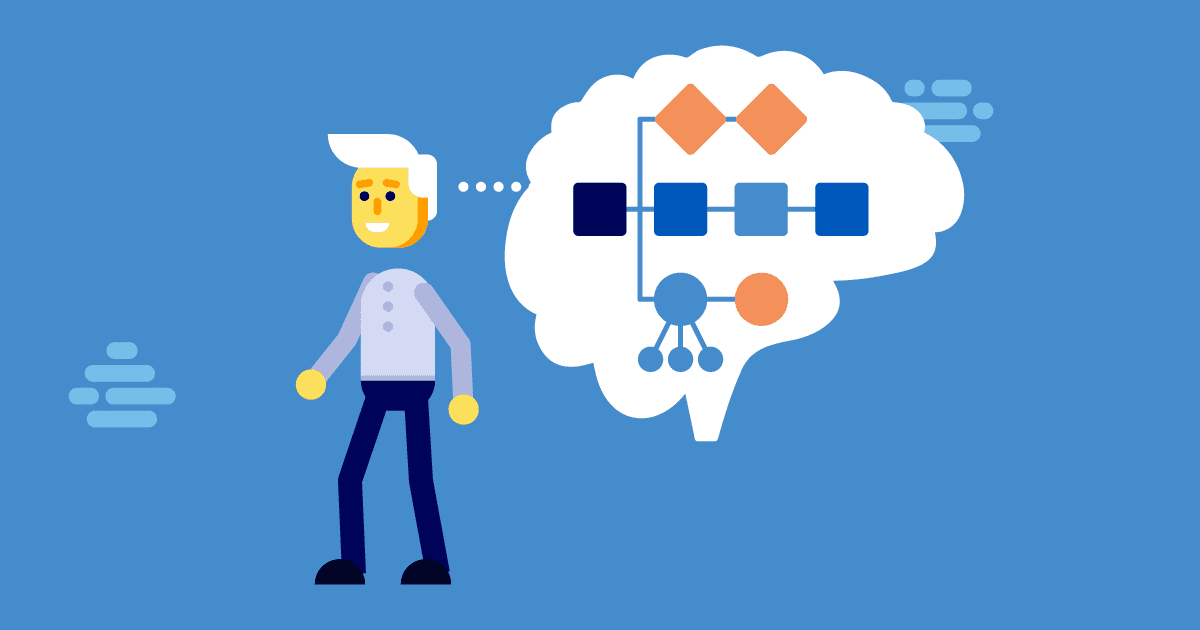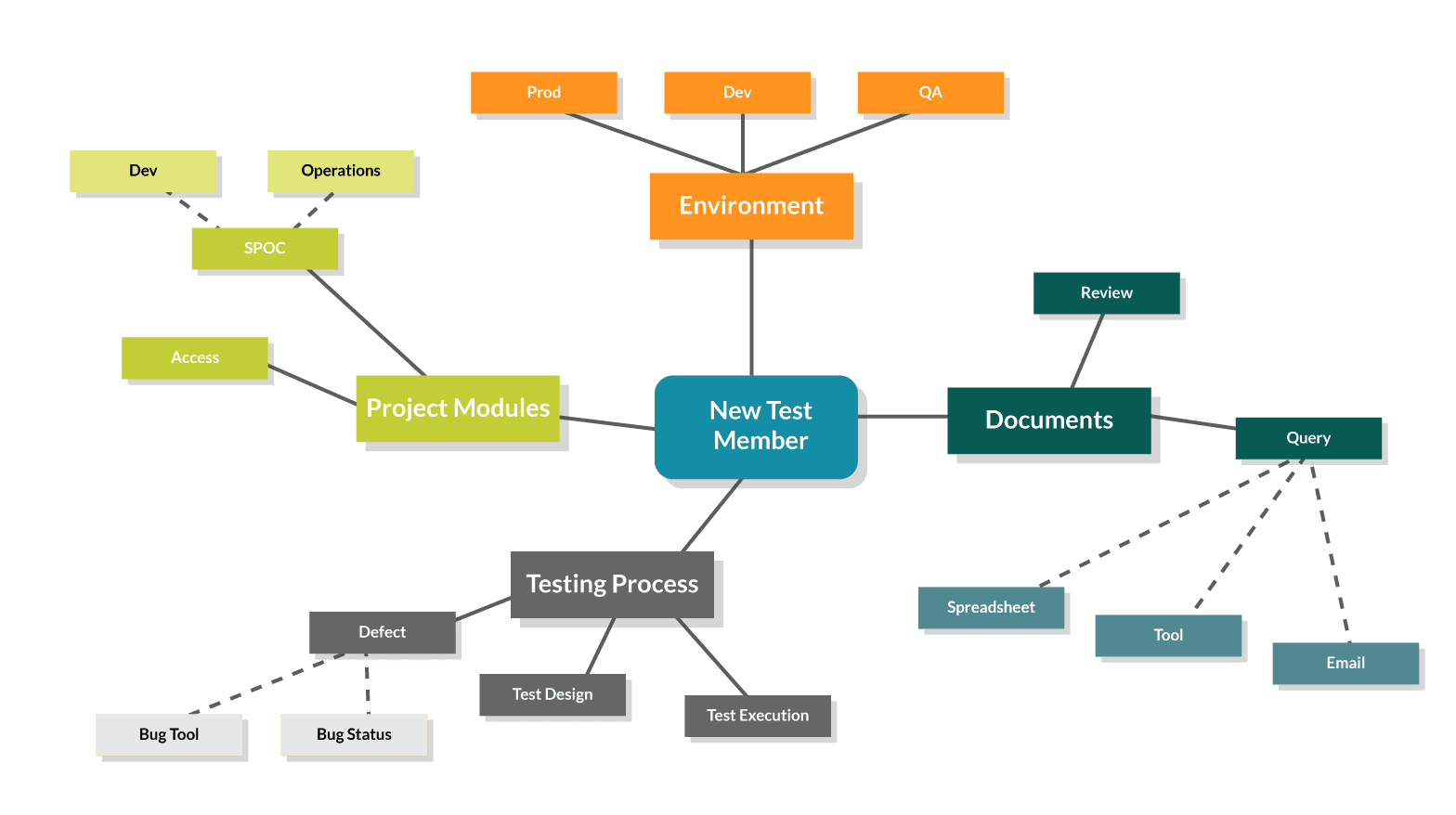A mind map is a diagram that visually represents a central topic, and any points that flow from it, which can be ideas, thoughts or strategies. Mind maps can be freehand structures sketched out on preferably a large sheet of paper or whiteboard, or created from customizable shape templates in an app. This format makes testing with mind maps a helpful activity for garnering raw ideas before they are sifted and structured.
A mind map begins with a central circle, ellipse, or box shape, where the main idea to be explored is written. Sympathetic to the way concepts are linked when we think, ideas, comments, lines of inquiries, and connected thoughts that spring from the main idea are the next parts to be added. These are referred to as subtopics. To show the main idea as the origin of these subtopics, related elements, secondary thoughts, or responses are written in their own circle, ellipse, or box. They are connected to the central idea by branches. Each of these subtopics can attach by other branches to a sibling or child topic. The reason mind mapping is favored in ideation sessions is the way the technique allows initially random or disorganized points to be captured from the brain, without any attention being paid to organization and schedule, which will be done later.
The use of mind maps is not restricted to Software Applications as they can be helpful to individuals in all circumstances, such as writing a business plan or creating a personal travel schedule. In this post, let’s see how mind maps are used in Software Testing.
Benefits of Mind Maps in Software Testing
Visual images make a more lasting impression on one’s mind, and the ideas represented in mind maps are images. In the world of testing, documenting every test case with detailed written steps makes creating documents a lengthy and overall cumbersome process. Using mind maps to record details in a visually compartmentalized way reduces documenting time and speeds up the overall process.
Mind maps also have the edge over conventional methods when it comes to reviewing test cases. The process of reading every line on multiple tabs of a spreadsheet or traversing through every test case in a testing tool ends up being generally overlooked by reviewers. With mind maps, reviewers can quickly assess the test process or flows in one place. This makes it easy for the reviewer to provide feedback and to identify essential test cases that might have been missed.

A mind map is an excellent tool to promote collaboration within the team. It is a handy tool that can be used by testers to describe their understanding of the project and discuss their status and progress with their colleagues. There’s no need to wait until the design phase to create a mind map because it can be made during any stage of the STLC (Software Testing Life Cycle). A lot of testers prefer creating mind maps for Test Plan, Test Strategy, and Test Scenarios. Some of the mind map tools also offer bug linking.
When Can We Use Mind Maps in Testing?
Building a mind map can begin as early as the Software Requirement Analysis Phase. Once the requirement of a feature is made available to the testing team, the tester can start to sketch out his understanding of the feature using a mind map. Mind maps help testers to create user flows and user scenarios that are used for discussion with the team. Receiving early feedback and the full picture about implementation always eases the work of a tester; the earlier a gap is identified, the better. Discussing mind maps with the developers also provides insight into the tester’s approach towards the testing.
Mind maps are also a useful tool for test planning. The approach, strategy, resource requirements, test schedule, and more, can be listed using a tree-shaped graphical representation, which will be eye-catching for all parties. Mind Maps are an outstanding tool for presenting the test plan to business and other stakeholders. Because all elements are instantly visible and in one place, they can help avoid the back and forth and reduce the time needed for discussion. Mind maps can also be particularly valuable when onboarding a new tester in the middle of an ongoing project.
Instead of a tester recording their understanding and comments in a word document, mind maps provide an easy way for testers to present their project knowledge graphically. A sample mind map representation is shown below:

Another important use for the mind map is Regression Testing. A mind map eases the work of a tester by clearly marking related areas to be tested when a bug gets fixed. For example, if a button on a page changes, a tester can quickly identify the related branches and include them for testing by looking at the mind map.
Over the years, mind maps have been used not only for feature testing but also for all other types of testing, including Exploratory Testing, Security Testing, and Performance Testing.
How are Mind Maps Created in Testing?
A good mind map requires a clear goal. It also needs significant features to be defined, and branches created for sub-features to help establish the relationships. Sitting together with a team of people and creating a mind map on a whiteboard is the most straightforward. That’s the preferred way during the ideation stage. Still, when it comes to Software Testing, where we need to revisit the test cases, tracking becomes a prominent feature. Mind maps can be created in Word or PowerPoint as too, but if the requirement needs mind maps to be made often, it is better to use specialised mind map tools. For testing, teams usually prefer to use tools for generating mind maps because they provide templates so maps can be made quickly. There are plenty of mind mapping tools available, such as xMind, MindMapper, Mind Meister. These offer online creation and easy communication. Test Insane is a testers’ site which has a repository of open source mind maps on various subjects of testing.
Conclusion
Mind maps are never going to replace the creation of detailed test cases and the conventional way of testing, but some projects demand a creative alternative. A mind map helps to bring creativity and can improve certain aspects of our testing. In the era of DevOps and Agile, mind maps have proven to be beneficial for all. Their ability to reduce the overall testing time and assist in speedy delivery is the differentiator.